Patterns for describing hollow elastic with knitting needles explain how to knit a face pattern so that it is double-sided. Such knitting is double-sided and hollow inside. It is usually used when decorating cuffs or collars for knitted, jersey products or as an element for outerwear.
Where is hollow rubber used?
The description of the hollow elastic band with knitting needles is useful for beginner craftswomen, since this element is found in the patterns of many products. It is performed both on straight and on circular, stocking knitting needles. The convenience of such a pattern is that it is elastic and does not lose its shape due to density.
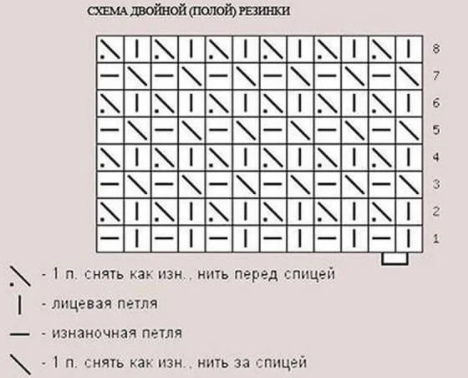
The elastic stretches well, but does not stretch after washing or when steaming with an iron. The double canvas on the finished product does not look bulky and too voluminous. The nuance of such a pattern is that it requires more threads than any other patterns.
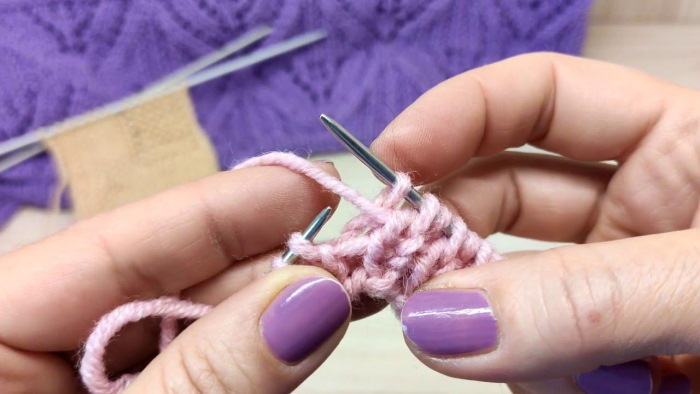
Hollow rubber is used in many elements or when creating a separate product:
- the bottom of skirts or trousers;
- the neck or stand-up collar of a sweater or jumper;
- upper part of hosiery;
- double-layer hats and scarves;
- double-layer mittens;
- sleeve cuffs;
- belt;
- strips for fastening;
- valves, etc.
How to calculate the required number of stitches for rib knitting?
To understand how many stitches you will need to cast on to make a double-layer elastic band, make a sample. This is done so that you do not have to unravel the finished product. The threads from the sample can also be unraveled later and used for work, or you can leave the sample for future use.
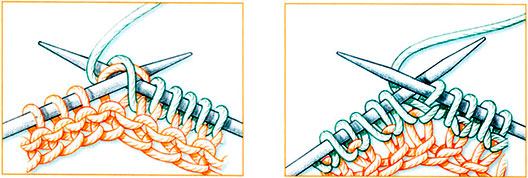
If a sample is left, the name of the thread and the number of knitting needles are also marked in order to correctly calculate the consumption of materials in the future.
A sample is knitted 5-10 cm wide and 15-20 rows high to get accurate calculations. If the sample is too small in size, then such a pattern is almost not compressed in width and it is difficult to calculate the loop consumption.
In a knitted sample, count how many loops fit in a certain gap (for example, 5 cm). Then determine what width of the product will be required in centimeters. Divide this number by 5 and multiply by the resulting number of loops in the sample gap.

Classic double or hollow elastic
Hollow elastic with knitting needles (the process is described in detail below) is obtained by casting on the required number of loops in the usual way. For example, cast on about 40 loops and then knit a classic 1*1 elastic. In each row, the 1st side loop is removed without knitting, the last one is knitted purlwise.

In the description of the pattern, for convenience, all designations are abbreviated and designated by initial letters (side - B, purl - I, front - L, front is removed as a purl, holding the thread in front of the knitting needle - LP, front is removed as a purl, holding the thread behind the knitting needle - LZ).
The scheme for making the elastic band is as follows.
| Row | Description |
| 1 | B remove, *L, I* (* - repeat to the end), BI. |
| 2, 4, 6 | B remove, *L, LP* (* - repeat to the end), BI. |
| 3, 5, 7 | B remove, *LZ, I* (* - repeat to the end), BI. |
| repeat next | They are gaining the required altitude |
Classic hollow elastic band with Italian set
The classic version of the elastic band when casting on stitches in the Italian way is slightly different from the previous one. Work with knitting needles No. 2. For this, a set of about 40 stitches is made in the sample (approximately 10 cm in width). For the sample, any other even number of stitches can be cast on.
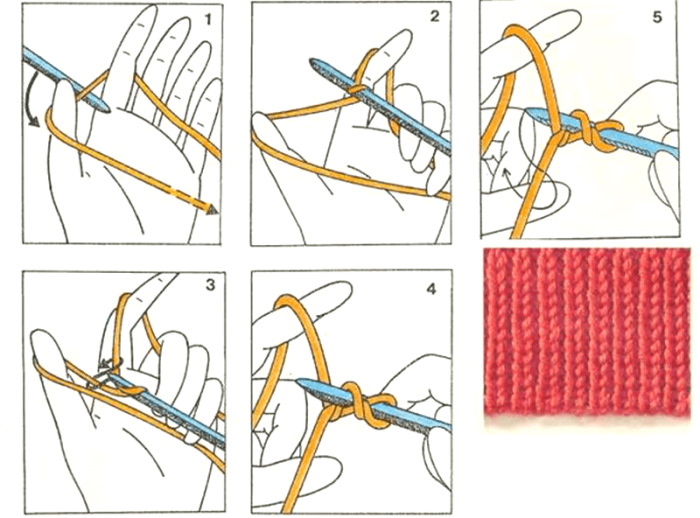
The Italian technique is similar to the pattern of a two-layer elastic band, so the pattern is formed immediately from the 1st row. The pattern of the finished elastic band will look the same as in the previous example, but the row where the loops were collected is not visible. This elastic band turns out to be more elastic and is more suitable for decorating the edge of socks or mittens.
In the description of the pattern, for convenience, all designations are abbreviated and designated by initial letters (side - B, purl - I, front - L, front is removed as a purl, holding the thread in front of the knitting needle - LP, front is removed as a purl, holding the thread behind the knitting needle - LZ).
Scheme of pattern composition.
| Row | Description |
| 1 | B remove, *L, LP* (* - repeat to the end), BL. |
| 2 and all subsequent ones | repeat the algorithm of the previous row to the desired height. |
Knitting a two-color hollow elastic band
A hollow elastic band with knitting needles (the scheme description is given in detail below) can be made from 2-color threads to make the product design brighter or more noticeable. For this, contrasting or similar colors are used - at your discretion. For the base, make a set of an even number of loops.
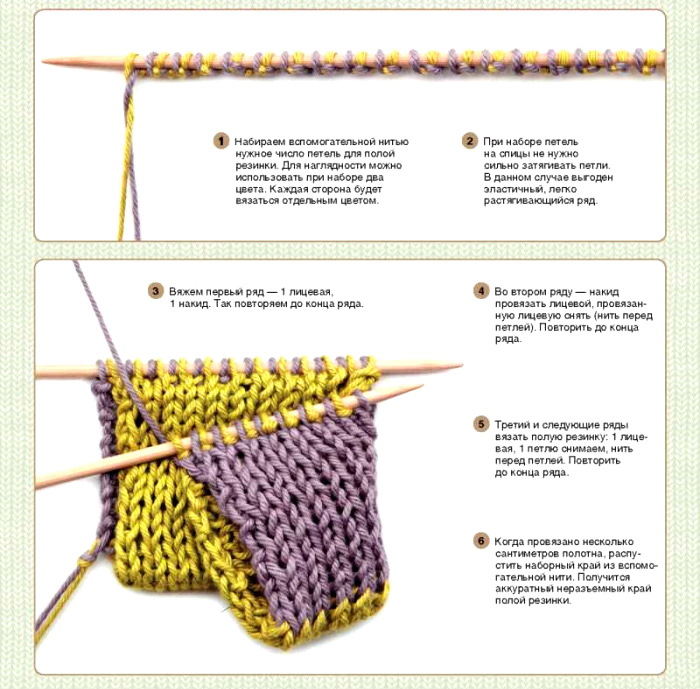
In the description of the pattern, for convenience, all designations are abbreviated and designated by initial letters (side - B, purl - I, front - L, front is removed as a purl, holding the thread in front of the knitting needle - LP, front is removed as a purl, holding the thread behind the knitting needle - LZ).
Scheme of pattern composition.
| Row (thread color A/B) | Description |
| 1
(color A) | B, *L, LP* (* - repeat to the end), B. |
| 2
(color B) | The knitting is moved to the beginning of the left knitting needle (the working fabric is not turned over).
B, *LZ, I* (* — repeat to the end), B. |
| 3
(color B) | Turning the canvas.
B, *L, LP* (* - repeat to the end), B. |
| 4
(color A) | Shift the working fabric to the left knitting needle.
B, *LZ, I* (* — repeat to the end), B. |
| Repeat rows 1-4 and then follow the algorithm | They are gaining the required altitude |
Double knitting in the round
Double elastic is often used when shaping cuffs or necklines. In this case, it is convenient to use the circular knitting method so as not to connect the pattern. Before starting to compose the pattern, make a set of loops and knit 2 preparatory rows.
Then they begin to design the pattern, which is alternated in rows and performed in a circle, repeating the pattern until the desired length of the elastic is reached.
For convenience, in the description of the pattern, all designations are abbreviated and designated by initial letters (side - B, purl - I, front - L, front is removed as a purl, holding the thread in front of the knitting needle - LP).
Scheme of pattern composition.
| Row | Description |
| 1 preparatory | *LP, I (yarn in front of purl)*, (* — repeat to the end). |
| 2
preparatory | *LP, I* (* — repeat to the end). |
| 1
and then all odd ones | *L, I remove (thread in front of I)*, (* — repeat to the end). |
| 2
and then all even ones | *Remove L behind the loop, I behind the back wall*, (* - repeat to the end). |
In rotary rows
Hollow elastic knitting (description of the pattern is given below in detail) can be designed using a classic or Italian set. Also, sometimes an additional thread is used when casting on and knitting to get a tight round edge, which looks like a factory one.
For convenience, in the description of the pattern, all designations are abbreviated and indicated by initial letters (side - B, back - I, front - L).
Scheme of making hollow elastic band with turning rows. The pattern is repeated every row and every 2 loops.
| Row | Description |
| 1 | B, *L (behind the front wall), I remove (thread in front of I)*, (* - repeat to the end), B. |
| Continue repeating the algorithm | Turn the fabric over and repeat the previous row. They gain the required height. |
Hollow elastic with openwork inserts
A hollow elastic pattern that includes an openwork element, in which the elastic is double-sided, and the openwork element has a front and back side. The fabric has a different width than with a regular elastic. Therefore, a method of casting on stitches is selected in which the edge will not be stretched too much. The knitting has a common beginning and a common end - the fabric is circular.
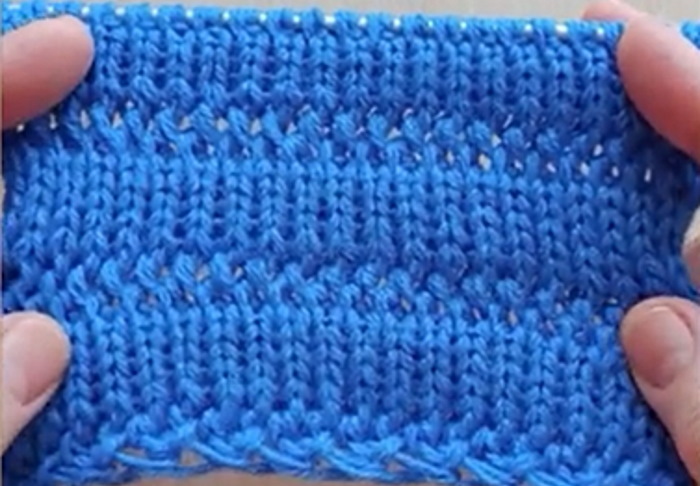
In this example, the method of casting on loops "loop with yarn over" is used. This element in the diagram is considered as 2 loops. Therefore, the number of such elements when casting on should be 2 times less, and then the number of loops is increased to the required number.
First, they make a sample and then knit based on it. elastic band with knitting needles the required size. Cast on 20 loops and 2 side loops for the sample. In this case, it is more convenient to count the number of loops in pairs. Therefore, cast on 2 pairs of loops of 10 and 2 side loops.
To prevent the edge from being stretched, make a set of loops 2 times smaller - 5 pieces and 2 side loops (1 standard, 5 loops with a yarn over, 1 standard loop). Then turn the fabric over and start forming the pattern.
For convenience, in the diagram description all symbols are abbreviated and designated by initial letters (side – B, purl – I, front – L, yarn over – H, 2 stitches together front – 2ВмЛ).
Scheme for creating an openwork pattern.
| Row | Description |
| 1 | B, *N, 2Vml* (* - repeat to the end), B. |
| 2 | Turn the fabric and double the stitches from this row. B, *N, L* (* - repeat to the end), B. You get 20 loops and 2 side loops. |
| 3 | Turning the canvas.
Algorithm as in row 1. |
They begin to form the elastic band.
| Row | Description |
| 4 | Turning the fabric. Yarn overs from the previous row are knitted in this row, and the loops are removed into the thread in front of the loops. B, *remove to the thread before the loop, L* (* - repeat to the end), B. |
| 5 and then gain the required height | Repeat the previous step. |
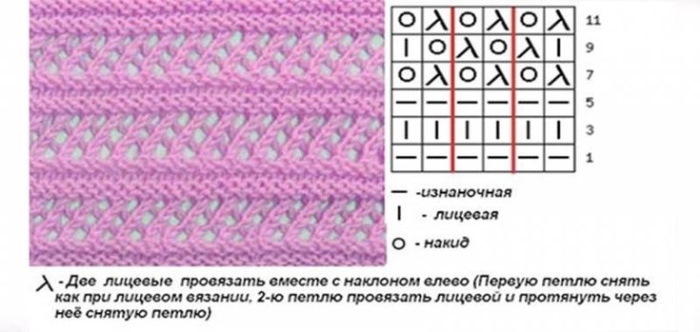
When you have collected the required number of rows of hollow elastic, move on to the openwork strip again.
| Row | Description |
| 1 | B, *N, 2Vml* (* - repeat to the end), B. |
| 2 | Turn the fabric over and begin knitting an openwork strip from the openwork side. B, *N, 2Vml* (* - repeat to the end), B. |
Move on to the hollow elastic pattern and then alternate rows as many times as necessary for the product. While working, remember that the width of the elastic pattern and the openwork insert are different, so adjust the number of loops on the knitting needles.
On circular needles
Hollow elastic with knitting needles (the scheme is described in detail below) can also be made on 4 knitting needles, as in the method of knitting socks or stockings. The 5th knitting needle is the working one.
This simple method is similar to the classic method, but transferred to another plane, which can be handled by beginners. This method of designing elastic is more suitable for knitting cuffs.
To begin with, it is recommended to try this method on a small sample, for which there are 10 loops on each knitting needle. The number of loops can be any, but it must be even (divisible by 2). Cast on a preliminary row in the classic way. To determine the beginning of the row, focus on the end of the thread from the beginning of the set in a circle.
For convenience, in the description of the pattern, all designations are abbreviated and designated by initial letters (front - L, slip the loop with the thread in front of the working fabric - SP, knit 2 loops together front - 2VmL).
Pattern composition scheme
| Row | Description |
| 1 | *L, SP* (* — repeat to the end). |
| 2 and all subsequent ones | Repeat the algorithm of the previous row. In all rows, the pattern of the previous row repeats the next one. Knit the required length. |
When you have reached the required height, you move on to making the pattern. When moving to another pattern, make sure that the loops are not crossed. The loops in the new row are gradually collected.
Scheme of transition from hollow elastic to the desired pattern
In this case, the transition remains the same width as the elastic band or slightly wider.
| Row | Description |
| 1 | 2ВмЛ – all loops to the end of the row. In the places where the needles cross, 1 loop remains. It is thrown onto the right needle, and moved to the next side. The loop is thrown back onto the left needle and 2ВмЛ are knitted. |
| 2 and all following | Knit the pattern as much as necessary. If you plan to make another pattern after the hollow elastic, after the 1st row of the transition, start forming a new pattern.
If you continue to knit the pattern of the 1st row, you will get a front surface with a narrow transition. |
Scheme of transition to pattern No. 2.
In this method, the transition becomes wider than the elastic band.
| Row | Description |
| 1 | All loops of row L. |
| 2 and all following | Knit the pattern as much as needed. If you plan to make another pattern after the hollow elastic band, after the 1st row of the transition, you start forming a new pattern. If you continue to knit the pattern of the 1st row, you get a stockinette stitch with a wide transition. |
Scheme of transition to pattern No. 3.
In this method, the inner (wrong) part of the cuff looks neater and less voluminous.
The temporary cuff is knitted with thinner threads. For this section, it is recommended to use any, even old threads or remnants of balls. Starting from the transition, add the main color thread and knit the loops from the previous row together with it.
| Row | Description |
| 1 | All loops of row L. |
| 2 | *L, the working thread is moved forward and the yarn is lifted onto the right knitting needle between the knitted and unknitted loops*, (* - repeat to the end). To keep an even number of loops on the loops, start with a knit loop on each loop and finish with a pick-up element. The element with the pick-up of the drawstring can be replaced with a yarn over if desired, but then the reverse side will have an untidy pattern in the form of drawstrings. |
| 3 | *L, SP* (* — repeat to the end).
In this row, repeat the pattern from the previous row - knit stitches as knit stitches, slip stitches. |
| 4 | Repeat the algorithm of the previous row. |
Cut off all the rows of the temporary cuff made of thin thread with scissors and remove all the protruding threads. Continue knitting according to the algorithm of steps 3-4 or move on to the desired pattern. With this method, there is no cast-on edge left on the wrong side and the pattern looks the same on all sides.
With serrated edge
The method of knitting a hem with teeth is suitable for finishing sweaters, cuffs, etc. The edge is double and the same on both sides. The knitting principle is the same in circular and rotary knitting.
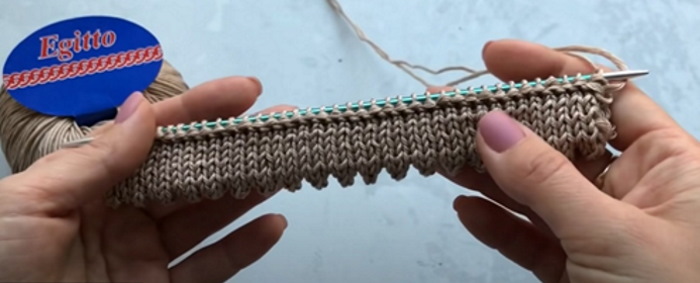
For convenience, in the description of the pattern, all designations are abbreviated and designated by initial letters (side - B, front - L, back - I, 2 loops together front behind the front walls to the right - 2ВмЛ, yarn over - H).
Scheme for making a pattern for rotary knitting:
- Cast on the required number of stitches. For this example, cast on 40 stitches.
- All loops in row I.
- Turn the fabric and knit all the loops L. Knit the front surface in this way to the desired height.
- On the front row, begin to form an openwork row - remove B, *2BmL, H*, (* - repeat to the end of the row), BI.
- Knit as many rows of stockinette stitch as were knitted before the openwork row. All loops are knitted I for the front walls.
- Proceed to make the hem. Fold the knitting fabric in half, find the very first loop. Fold the fabric so that the first knitting loop lies next to the first loop on the knitting needle. Transfer the first loop to the working knitting needle, it should be the first in the working row. Knit 2BmL. Transfer the next loop from the preliminary row to the knitting needle and knit 2BmL. Continue the algorithm to the end.
- At the bend, a jagged pattern is obtained. Then, on the needles, continue knitting with the front surface or move on to another pattern.
Scheme for creating a pattern for circular knitting:
- Cast on the required number of stitches on circular knitting needles and close the knitting in a circle.
- Knit in a circle with the front surface to the desired height. In this example, knit 7 rows to the fold element.
- Perform a row with an openwork pattern.
- The front surface is repeated in a circle for the same number of rows as before the openwork row. When knitting in the round, all rows are front, so only front loops are knitted.
- The hem is made in the same way as the turning knitting.
Double hem with non-scalloped elastic
Method of knitting a hem without teeth. This method is similar to the previous one, but the edge of the product is smooth and elastic. In this example, knitting is done on circular needles, but, if desired, you can repeat this pattern on straight needles.
For convenience, in the description of the pattern, all designations are abbreviated and designated by initial letters (side - B, front - L, back - I, 2 loops together front behind the front walls to the right - 2ВмЛ, yarn over - H).
Pattern composition scheme:
- Cast on the required number of loops on circular knitting needles in the usual way and close the loops into a circle. To do this, remove the first loop on the left knitting needle to the right one and pull the next loop on the right knitting needle through the removed one. For ease of knitting, place a marker or pin on this tightened loop to understand where the beginning of the row is. The marker can be removed at the end of the work; it will not damage the knitting fabric.
- Perform a classic 1*1 elastic (alternate L and I until the end of the edge).
- Knit the elastic to the desired length. In this example, knit 12 rows (about 3 cm). When working, this length can be adjusted at your discretion.
- Start to bend the row and knit the edge loops from the cast-on row and the loops on the knitting needle. Insert the right knitting needle into the loop with the marker, transfer it to the left knitting needle and knit 2ВмЛ. Find the 2nd loop on the cast-on row, transfer it also to the knitting needles and knit further 2ВмЛ. Continue the algorithm to the end of the row.
- The end of the knitting is cut off or hidden inside the double elastic band.
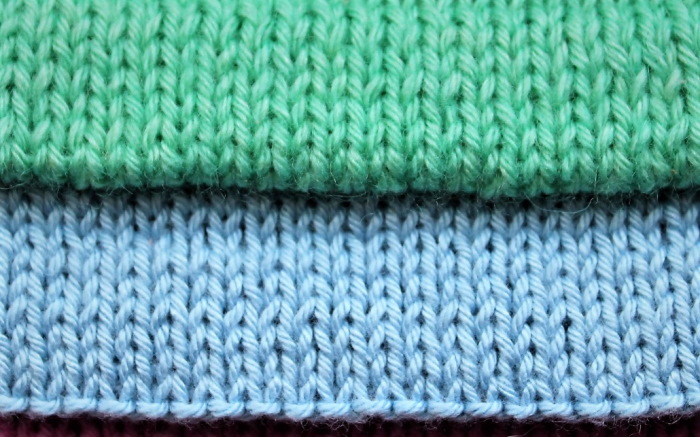
How to close a hollow elastic band
The description of a hollow elastic band with knitting needles does not always include the moment of closing the row. When the required length has already been dialed on the knitting needles, they begin to finish knitting. The loops are closed in different ways. The method depends on the product in which the elastic pattern was used.
To close a row of elastic on the neck of a jumper or sweater, knit according to the pattern (front with front, back with back with removed back). With this method, the edge of the product is elastic and the sweater can be easily removed over the head.
If you close a row in a fastening element or on a belt where additional elasticity of the elastic is not needed, follow the algorithm. This way the edge is rigid and does not stretch, so that buttons or other fastening elements of the products do not fall out.
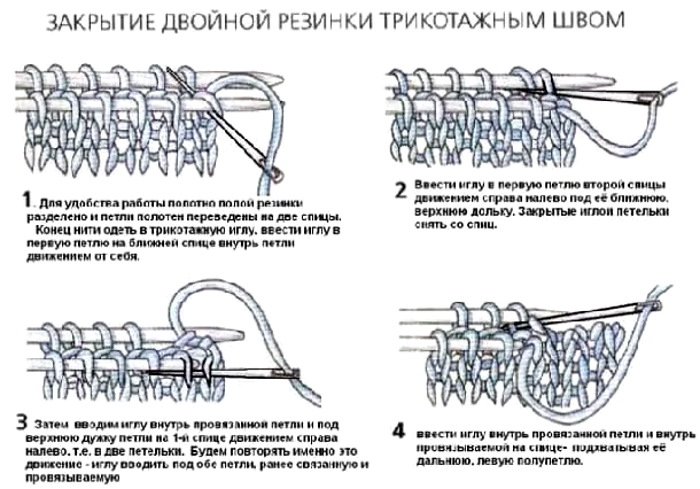
The order of closing the loops:
- Remove the side loop.
- The next loop is not knitted and is removed.
- The next slipped loop behind the fabric is knitted purlwise, pulled through the previous slipped loop. This loop is pulled through the side loop again.
- Continue knitting 2 stitches together and pulling through the previous one on the right needle.
Video on how to knit a hollow elastic band
The hollow elastic is called "elastic", although it looks like a double piece of stockinette stitch. Often the hollow elastic is called double, because it consists of two pieces - front and back.
